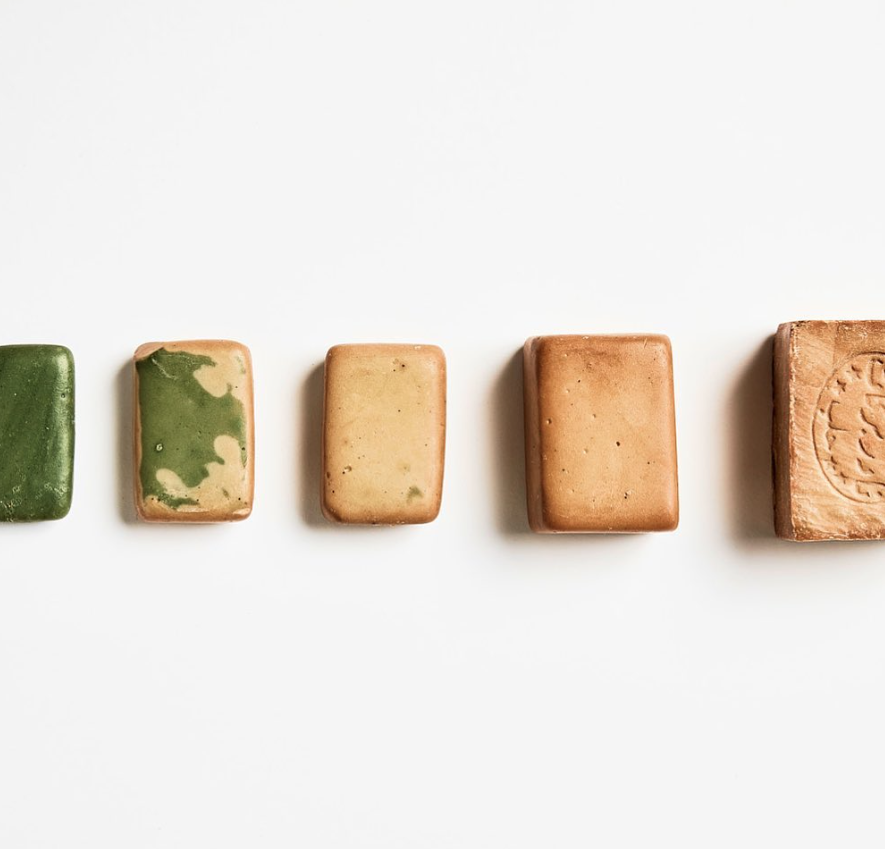 Image 1 of 4
Image 1 of 4

 Image 2 of 4
Image 2 of 4

 Image 3 of 4
Image 3 of 4

 Image 4 of 4
Image 4 of 4





Syrian Alepp Soap
Aleppo Soap is rich and hydrating and has been used for centuries in the Middle East.
Olive oil and Laurel berry oil are the only two ingredients that remain in Aleppo Soap following its nine month curing process. During production, olive oil, laurel berry oil, lye and water are combined to create saponification, which is the chemical reaction between the lye and fat that makes bar soap
How the Soap is made.
Traditional Aleppo soap uses a 'hot process' with large vats of olive oil, water and lye. Underground fires or other sources heat the ingredients over days so the oil reacts with the lye and water to create a thick liquid soap.
The hero ingredient is Laurel oil which comes in at the end of the process. The mix is taken from the vat and poured over a large sheet of waxed paper on the floor of the factory. At this point, the soap is a large, green, flat mass, and it is allowed to cool down and harden.
The soap is then cut into cubes and stamped and stacked in staggered cylindrical shapes to allow maximum air exposure and are then aged from six months to a year.
While it is ageing, the soap goes through several natural chemical changes. The free alkaline content of the soap (the alkaline which did not react with the oil during saponification) breaks down upon slow reaction with air. The moisture content of the soap is also reduced, making the soap hard and long- lasting. And lastly, the external colour of the soap turns pale gold, while the inside remains green.
Is Aleppo Soap perfumed?
Only by nature! Aleppo has a wonderful natural, spicy/earthy scent that comes from the Laurel berry oil. It is a distinct fragrance synonymous with the soap.
Gift wrapped.
Aleppo Soap is rich and hydrating and has been used for centuries in the Middle East.
Olive oil and Laurel berry oil are the only two ingredients that remain in Aleppo Soap following its nine month curing process. During production, olive oil, laurel berry oil, lye and water are combined to create saponification, which is the chemical reaction between the lye and fat that makes bar soap
How the Soap is made.
Traditional Aleppo soap uses a 'hot process' with large vats of olive oil, water and lye. Underground fires or other sources heat the ingredients over days so the oil reacts with the lye and water to create a thick liquid soap.
The hero ingredient is Laurel oil which comes in at the end of the process. The mix is taken from the vat and poured over a large sheet of waxed paper on the floor of the factory. At this point, the soap is a large, green, flat mass, and it is allowed to cool down and harden.
The soap is then cut into cubes and stamped and stacked in staggered cylindrical shapes to allow maximum air exposure and are then aged from six months to a year.
While it is ageing, the soap goes through several natural chemical changes. The free alkaline content of the soap (the alkaline which did not react with the oil during saponification) breaks down upon slow reaction with air. The moisture content of the soap is also reduced, making the soap hard and long- lasting. And lastly, the external colour of the soap turns pale gold, while the inside remains green.
Is Aleppo Soap perfumed?
Only by nature! Aleppo has a wonderful natural, spicy/earthy scent that comes from the Laurel berry oil. It is a distinct fragrance synonymous with the soap.
Gift wrapped.
Aleppo Soap is rich and hydrating and has been used for centuries in the Middle East.
Olive oil and Laurel berry oil are the only two ingredients that remain in Aleppo Soap following its nine month curing process. During production, olive oil, laurel berry oil, lye and water are combined to create saponification, which is the chemical reaction between the lye and fat that makes bar soap
How the Soap is made.
Traditional Aleppo soap uses a 'hot process' with large vats of olive oil, water and lye. Underground fires or other sources heat the ingredients over days so the oil reacts with the lye and water to create a thick liquid soap.
The hero ingredient is Laurel oil which comes in at the end of the process. The mix is taken from the vat and poured over a large sheet of waxed paper on the floor of the factory. At this point, the soap is a large, green, flat mass, and it is allowed to cool down and harden.
The soap is then cut into cubes and stamped and stacked in staggered cylindrical shapes to allow maximum air exposure and are then aged from six months to a year.
While it is ageing, the soap goes through several natural chemical changes. The free alkaline content of the soap (the alkaline which did not react with the oil during saponification) breaks down upon slow reaction with air. The moisture content of the soap is also reduced, making the soap hard and long- lasting. And lastly, the external colour of the soap turns pale gold, while the inside remains green.
Is Aleppo Soap perfumed?
Only by nature! Aleppo has a wonderful natural, spicy/earthy scent that comes from the Laurel berry oil. It is a distinct fragrance synonymous with the soap.
Gift wrapped.
